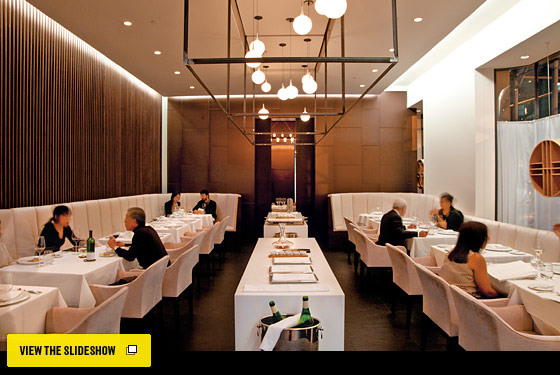
Photographs by Danny Kim
Jungsik, which opened not long ago in the fabled old Chanterelle space in Tribeca, aspires to be the first modern haute-Korean restaurant in all of New York City. This means that at the bar you can enjoy soothing $17 cocktails rimmed with crushed seaweed or mixed with exotic ingredients like green plums, and an unfiltered Korean rice wine called makgeolli. The tables at this ambitious little establishment are covered with crisp white linens, and the painstakingly prepared dinners are served in handcrafted white bowls and giant plates as big as gull wings. There’s classic Korean fried chicken on the menu, but it’s stuck with a bamboo toothpick and served as a thimble-size amuse. The only dinner options are a three-course $80 or five-course $115 prix fixe, which, as any David Chang freak can tell you, is almost enough to buy the entire menu at the original Momofuku outlet.
The man behind this rash experiment in international dining is a talented young cook named Jung Sik Yim. He’s a veteran of Aquavit and Bouley, as well as several grand, Michelin-approved kitchens in Europe, and he runs a popular restaurant in Seoul called Jungsik Dang, which has been praised for its “nouvelle” approach to Korean cuisine. Here at Yim’s New York branch, the formerly ornate space has been remodeled in a generic modern style (clean, unadorned walls, white curtains over the windows) and divided into three dimly lit, slightly feng shui–challenged rooms, the last two separated by a sliding door. On my visits, dinner was served in the narrow middle room, which has white banquettes along both walls and is set with two small rows of tables that face each other, like in the dining car of a train. There’s also a white acrylic bar in the front of the house and a curiously dead gallery space called Cube, where you can examine (and purchase) the work of Korean artists.
“This isn’t like chowing down with the family on 32nd Street,” said one of the Korean-food snobs at my table as she took hesitant little bites of a daintily deconstructed salad version of bibimbap made with two kinds of carefully diced tomato, among other things, and a spoonful of savory green sorbet flavored with arugula. The categories from which diners create their meal at Jungsik are salad, rice / noodles, seafood, meat, and dessert. Most of the dishes are served in petite tasting portions, and many have names like Four Seasons (an intricately conceived though slightly wan-tasting boutique-vegetable tart), Spoonable (acorn-squash purée topped with beet sauce and in a cloud of tart yogurt foam), and Mr. Kim Halibut (a beautifully poached piece of fish spackled on top with a scrim of crushed seaweed and propped on a square of daikon radish).
The best of these nouvelle creations are the ones with roots in classic Korean homestyle cooking. In the rice / noodle category, my tasters and I enjoyed a delicate, risotto-style version of the beefy rice dish miyeok, and an ingenious creation simply called “sea urchin” made with a mash of seaweed-flavored rice and fried quinoa topped with shaved onion, dabs of fresh uni, and a spicy kick of house-made kimchee. And Yim’s delicious rendition of the winter noodle dish kalguksu is threaded with whole clams and sliced garlic, and spiced with a kick of jalapeño. Among the meat dishes, the Classic Galbi short ribs are dressed with boutique red peppers and crispy fried rice cakes shaped like peanuts, and the chef’s signature version of pork belly (“Five Senses pork”) is cut in soft, crunchy-topped squares, flavored with pickled sesame-seed leaves, among other things, and served on a piece of polished black slate.
As one stylish, mannered course succeeds another, however, it’s hard not to feel that infectious, communal quality that makes good Korean cooking special being slowly leached out of the meal. One problem is the dreary, slightly haunted setting, which doesn’t match the ambition or artistry of the best of the cooking. Another is the prix fixe setup, which, aside from the cost, adds a stagy formality to the proceedings. “I don’t think I’ll be bringing my grandparents here,” said the Korean snob as she picked at dated Bouley-style creations like truffle chicken (boneless, sous vide–softened rounds of bird in a beef-and-radish broth) and Yim’s Tribeca lobster, which was expertly poached in a rich butter sauce and admirably plated with an assortment of boutique microgreens, but lacked any modern gourmet twist.
The elaborate tasting menus at Jungsik change on a seasonal basis, and if you have the financial resources, you can complement your nouvelle-Korean dinner with professionally chosen wine pairings (an additional $50 for the three-course dinner, $75 for the five-course). There were only four desserts on the menu I sampled, and, in accordance with gourmet tradition, they’re accompanied with palate-cleansing sorbets and plates of financiers and macarons tinged, in this instance, with exotic Asian ingredients like mugwort leaf and yuzu. The most interesting pastry creation is a kind of deconstructed French-style baba, soaked not with rum but citrus juices and arranged on the plate with bits of apple and spumes of Calvados foam. The least interesting (pumpkin-flavored panna cotta and segments of “raspberry cremeux,” a strange pound cake made from burdock root with the consistency of toothpaste) taste less like some groundbreaking form of international fusion than failed experiments from the doomed kitchen at Chanterelle.
Jungsik
Address: 2 Harrison St., nr. Hudson St.; 212-219-0900
Hours: Dinner Monday through Saturday 5 p.m. to 10:30 p.m.
Prices: $80 for three-course prix fixe,$115 for five-course.
Ideal Meal: Bibimbap, sea urchin, miyeok or spicy kalguksu, Five Senses pork, apple rice-wine baba.
Note: The pictures of Yim’s dishes on the restaurant’s website are some of the most beautiful food photos this grumpy critic has ever seen.
Scratchpad: Three stars for the ambitious cooking, minus one for the dreary space and another for the awkward and expensive prix fixe setup.

Photo: Danny Kim
